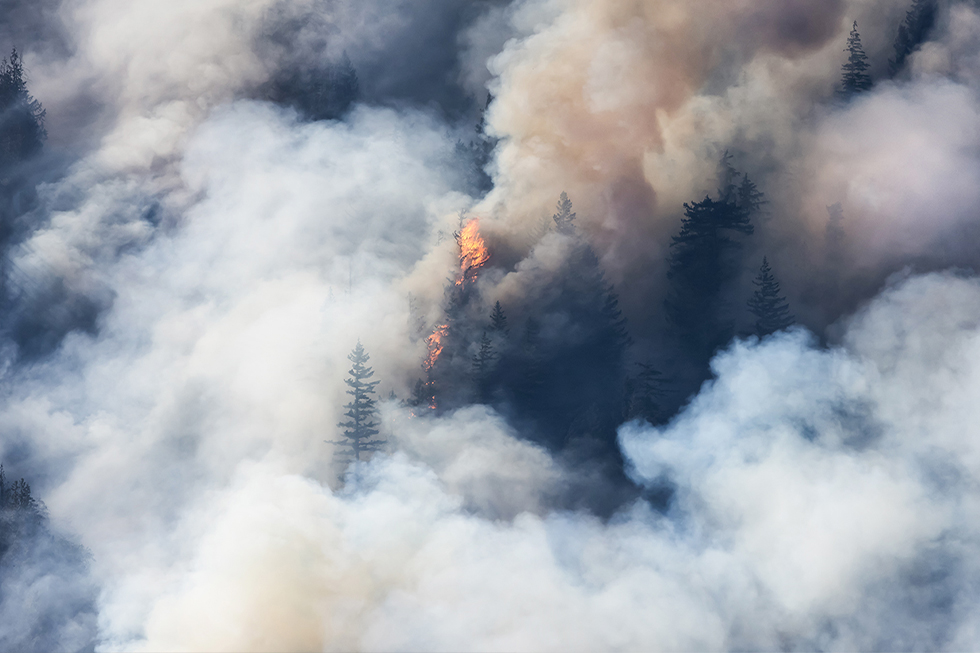As wildfire season progresses with escalating wildfires, navigating smoke safety and ensuring the well-being of employees in industrial and outdoor settings has become a top priority.
At TEAM, we understand the urgency of the situation and are committed to providing comprehensive smoke safety solutions to protect our and our clients’ workforce.
Wildfire Smoke as a Workplace Hazard
Wildfire smoke poses a significant challenge to the safety of employees, particularly in certain workplaces that are more susceptible to its adverse effects. In industrial facilities where outdoor operations are prevalent or where air circulation is less controlled, the presence of smoke particles can exacerbate existing workplace hazards.
When wildfire smoke infiltrates indoor workspaces, it can compromise air quality, leading to respiratory issues and eye irritation among employees. Moreover, prolonged exposure to smoke can result in reduced visibility, hindering safe navigation and increasing the risk of accidents. As an industrial facilities management company, addressing this concern is of utmost importance for the well-being of our workforce.
A study published in The Lancet Planetary Health estimates that at least 33,000 people a year die from pollution caused by wildfire smoke.
By acknowledging the unique hazards posed by wildfire smoke and incorporating comprehensive smoke safety measures, TEAM strives to safeguard employees from potential health risks. Our air quality monitoring services allow us to identify periods of heightened smoke levels, enabling timely communication and strategic decision-making. Our emergency response management and preparedness services play a critical role in ensuring that employees and companies are well-informed and well-prepared to handle smoke-related crises effectively. Additionally, our safety training programs equip employees with the knowledge and skills to navigate hazardous conditions, use personal protective equipment correctly, and respond to emergencies, fostering a proactive safety culture.
Short-term wildfire smoke exposure linked to 440 deaths in Canada a year.
Ignoring the impact of wildfire smoke in industrial settings not only jeopardizes employee health but can also lead to a decline in productivity and an increase in absenteeism. By proactively addressing this concern, we demonstrate our commitment to the safety and well-being of our employees. Together, we can create a resilient work environment that empowers employees to make informed decisions, protect themselves, and adapt to ever-changing smoke conditions. As we navigate the rising challenge of wildfires, our dedication to providing cutting-edge smoke safety solutions remains unwavering, ensuring that our clients can focus on their core operations with confidence, knowing their employees’ safety is in capable hands.
Health implications of inhaling wildfire smoke
Inhaling wildfire smoke can have serious health implications, particularly when individuals are exposed to high levels of smoke over an extended period. The smoke generated from wildfires contains a complex mixture of fine particulate matter, carbon monoxide, volatile organic compounds (VOCs), and other harmful gases. When inhaled, these pollutants can penetrate deep into the respiratory system, causing irritation of the nose, throat, and lungs.
Individuals with pre-existing respiratory conditions, such as asthma or chronic obstructive pulmonary disease (COPD), are particularly vulnerable to exacerbated symptoms and may experience difficulty breathing, coughing, wheezing, and shortness of breath. Additionally, prolonged exposure to wildfire smoke has been linked to increased rates of respiratory infections, cardiovascular problems, and even premature death in extreme cases.
Pregnant women, children, the elderly, and those with compromised immune systems are also at higher risk of experiencing adverse health effects. For this reason, it is crucial to implement comprehensive smoke safety measures in industrial facilities and prioritize the well-being of employees who may be at greater risk due to their working environment.
Five Best Practices for Employees in Areas of Bad Air Quality
- Wear Appropriate Personal Protective Equipment (PPE): When air quality is compromised, it is crucial for employees to wear suitable PPE. Respiratory protection, such as N95 masks or respirators with a higher filtration level, can help reduce exposure to harmful smoke particles. Additionally, safety goggles and face shields can protect the eyes from irritation caused by smoke.
- Limit Outdoor Activities: Encourage employees to minimize outdoor work as much as possible during periods of poor air quality. If feasible, schedule tasks that require outdoor exposure for times when air quality improves. Indoor workspaces can provide a safer environment during smoky conditions.
- Create Safe Zones: Designate certain areas within the facility as “safe zones” with enhanced air filtration systems to provide employees with temporary respite from smoke. These zones should be easily accessible and well-ventilated.
- Stay Informed: Keep employees informed about air quality updates and any changes to emergency response plans. Regularly monitor local news and official agencies for wildfire updates and health advisories. Encourage open communication with employees about their health concerns.
- Promote Hydration and Wellness: Smoke inhalation can lead to dehydration and other health issues. Encourage employees to stay hydrated by providing access to clean drinking water and remind them to take regular breaks to rest and recover from exposure to smoky conditions.
- Modified work schedules: By rescheduling outdoor tasks or allowing flexible work hours, companies can help employees avoid hazardous conditions and reduce the risk of respiratory issues and other health problems associated with wildfire smoke.
Between COVID-19, wildfires, and other environmental issues, there has been an increased awareness among employers and employees – especially among frontline workers – of the importance of air quality. It’s essential for companies to approach air quality issues comprehensively rather than from a narrow perspective. They should evaluate the adequacy of their current systems to ensure the protection and safety of their workforce during periods of extremely poor air quality.
Employers and employees should work together to create strategies for minimizing smoke exposure when required. In situations where workers need to operate in smoke-prone environments, particularly for extended periods, or if an individual is susceptible to wildfire smoke and experiences adverse health or safety effects, these measures can be adopted to mitigate smoke exposure.
TEAM’s Smoke Safety Services
- Air Quality Readings at Customer Sites: We offer advanced air quality monitoring systems to assess the level of smoke and particulate matter in the surrounding environment. By deploying state-of-the-art sensors, we can accurately measure air quality at our clients’ facilities. These real-time readings allow us to develop appropriate strategies to safeguard employees from potential health hazards.
- Improved Air Quality Measures: At TEAM, we enhance indoor air quality (IAQ) within your facility by leveraging a deep understanding of your building’s intricate systems and airflow dynamics. Employing cutting-edge technologies, we assess areas where air quality might fall short. This analysis enables us to target sources of contaminants and implement a comprehensive approach that encompasses source control and effective ventilation and filtration systems.
- Emergency Response Management and Preparedness Services: Preparedness is key to mitigating the impact of wildfires and smoke on industrial facilities. Our team works closely with clients to develop comprehensive emergency response plans tailored to their specific needs. From evacuation protocols to communication strategies, we ensure that all necessary measures are in place to safeguard employees during crisis situations.
- Safety Training for Employees: Proper education and training are essential in ensuring that employees are equipped to handle smoke-related safety challenges. We conduct specialized safety training programs that educate your workforce about the risks associated with exposure to smoke, the proper use of personal protective equipment (PPE), and evacuation procedures. Our goal is to empower employees with the knowledge and skills they need to respond effectively in smoky conditions and protect their well-being.
- Technology, Innovation & Data: We embrace innovation by constantly evaluating new technologies and partnering with vendors who offer cutting-edge solutions. Through continuous building management and advanced sensor systems, we closely monitor IAQ parameters, ensuring real-time insights into air quality dynamics. This data-driven approach empowers us to make informed decisions for optimal IAQ enhancement. Embracing novel cleaning technologies, such as UV disinfection, ionizers, robotic scrubbers, and automated support systems, allows us to target contaminants more effectively. By integrating these solutions, TEAM delivers a healthier and environment for all workers.
As wildfires continue to pose a significant threat to communities and industries alike, prioritizing smoke safety in industrial facilities is imperative. At TEAM, we are dedicated to providing cutting-edge solutions to protect employees during these challenging times. By offering air quality readings, emergency response management, and preparedness services, we ensure that your workforce remains safe and well-prepared in the face of smoke-related hazards.
By implementing the best practices outlined in this blog, we can collectively mitigate the impact of smoke on employee health and well-being.






